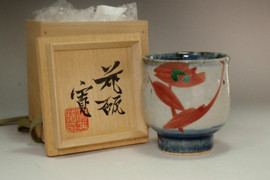Kawai Kanjiro (1890-1966) Vintage pottery teacup #4321
- SKU:
- 4321
- Shipping:
- Free Shipping
- width: approx. 7cm (2 3⁄4in)
- height: approx. 8cm (3 5⁄32in)
- weight: 169g (w/ box 299g)
Kawai Kanjiro (1890-1966)
After graduating from Tokyo Higher Polytechnical School, Kawai worked and studied at the Kyoto Research Institute for Ceramics. In 1920, he built his own independent kiln in Gojozaka (inherited from Kiyomizu Rokubei V), and married Tsune Kawai (née Mikami Yasu) the same year.
His first ceramics exhibition was held the following year at Tokyo's Takashimaya Department Store. From the beginning, he studied ancient Chinese and Korean ceramics, and was highly praised for developing pieces with ever more unique molds, but he held doubts about his style, and temporarily ceased to make pottery. It was around this time he was introduced to Yanagi Soetsu by Mashiko potter Hamada Shoji. In 1926, after wishing for the establishment of a "Japanese Mingei Museum" he instigated the mingei (folk art) movement, along with Hamada, Yanagi, Bernard Leach, Munakata Shiko and others.
He resumed making pottery again in 1929, pursuing "the beauty of use" and undergoing a massive change towards mingei style pieces. In 1937 he won the Grand Prix at the Paris Exhibition Internationale for "Tetsushinsha sokazutsubo", and another Grand Prix at La Triennale di Milano in 1957 for "Shiroji sokaehenko".
















